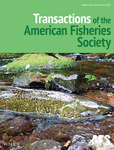Journal list menu
Export Citations
Download PDFs
ISSUE INFORMATION
FEATURE ARTICLE
Diversity in freshwater life history in spring and summer Chinook Salmon from the Fraser River, Canada
- Pages: 129-144
- First Published: 20 November 2022
Impact Statement
Threatened and endangered Chinook Salmon populations from the upper Fraser River have complex patterns of freshwater habitat use that includes extensive use of the Fraser River main stem.
ARTICLES
Lineage and hybridization effects on size potential in the Largemouth Bass complex
- Pages: 145-168
- First Published: 20 November 2022
Impact Statement
Genetic analyses indicated positive size-related heterosis for F1 hybrids in the Largemouth Bass complex, and size potential scaled positively with levels of Florida Bass alleles, but non-introgressed Florida Bass were still much more likely to reach large size.
Landscape characteristics influence projected growth rates of stream-resident juvenile salmon in the face of climate change in the Kenai River watershed, south-central Alaska
- Pages: 169-186
- First Published: 05 December 2022
Impact Statement
As climate change warms water temperatures in salmon-bearing Gulf of Alaska watersheds over the next century, juvenile Chinook and Coho salmon that feed at lower rates and live in low-elevation tributaries are likely to see the greatest decreases in their summer growth rate.
Hatchery supplementation increases potential spawning stock of Rio Grande Silvery Minnow after population bottlenecks
- Pages: 187-200
- First Published: 05 January 2023
Impact Statement
Releasing hatchery-reared Rio Grande Silvery Minnow after years of poor reproduction increases the number of fish spawning during the following year, thus helping to maintain the species' ability to persist through drought and climate change.
A comparison of methods for estimating juvenile salmon habitat capacity to assist with restoration planning and evaluation
- Pages: 201-216
- First Published: 05 January 2023
Impact Statement
Estimating the number of juvenile salmon a stream reach can support is critical for restoration planning. A comparison of seven methods to estimate juvenile salmon capacity found simple habitat expansion methods provide suitable estimates for reach-scale restoration planning.
Association of an endemic leuciscid, the Sandhills Chub, with microhabitat features and watershed-level habitat characteristics
- Pages: 217-231
- First Published: 09 January 2023
Impact Statement
The Sandhills Chub is a headwater stream specialist endemic to the Sandhills ecoregion in North Carolina and South Carolina. It has been extirpated from several locations in South Carolina; thus, information on habitat preferences is needed to guide conservation and restoration efforts.
The effect of reducing dietary lipid and food availability on precocious male maturation in Chinook Salmon: A production-scale hatchery experiment
- Pages: 232-252
- First Published: 10 January 2023
Impact Statement
This study demonstrates that altering the composition and amount of feed can generate salmon smolts with differing physiological attributes and levels of early maturation. These findings may influence hatchery programs to alter standard feeding practices to produce smolts with more desirable phenotypes and thus increase hatchery productivity. The most important implication is that hatchery programs have the ability to make choices about feeding programs that allow them to produce smolts with varying performance.
Timing and route of migration of mature female blue crabs in a large, wind-driven estuary
- Pages: 253-269
- First Published: 30 March 2023
Impact statement
Marine fish and shellfish that spawn in predictable locations are particularly vulnerable to overfishing when fishers target their spawning grounds or along regular migration routes leading to spawning grounds. Through a collaborative mark–recapture study with commercial crabbers, we identified the timing, rate, and location of migration by mature female blue crabs, whose population numbers are at historic lows. Extending no-take spawning sanctuaries to locations with high concentrations of mature females may reduce fishing mortality and enhance spawning success.




